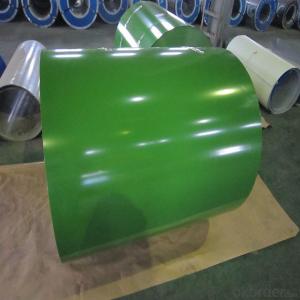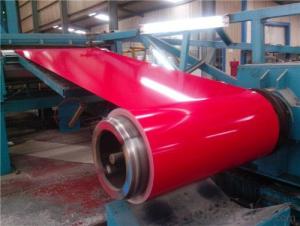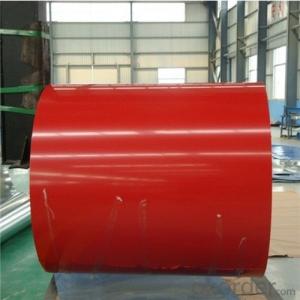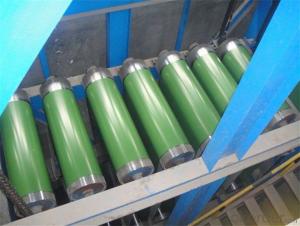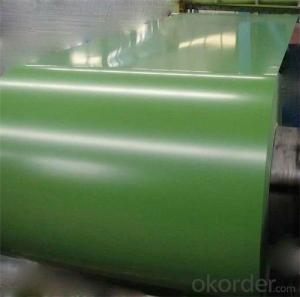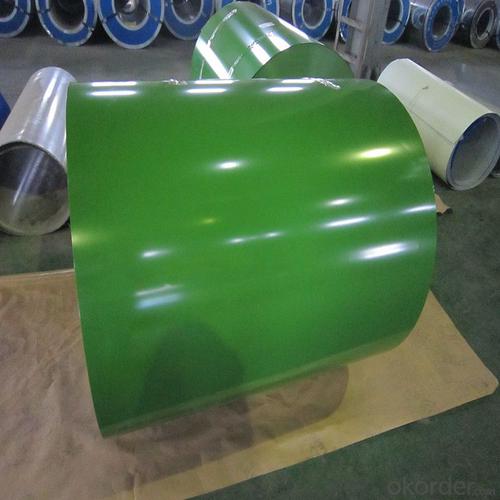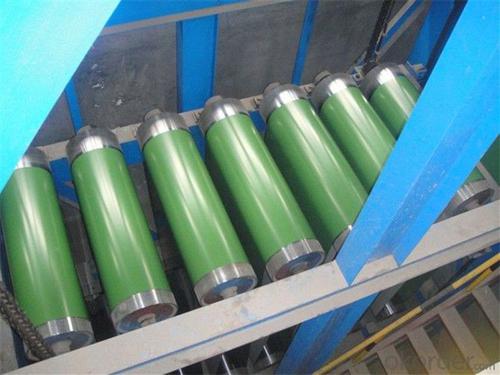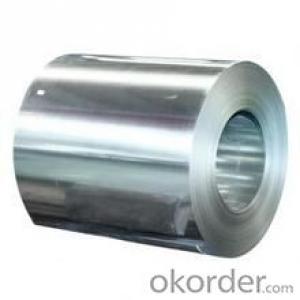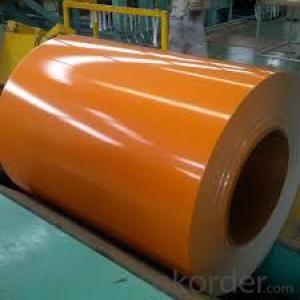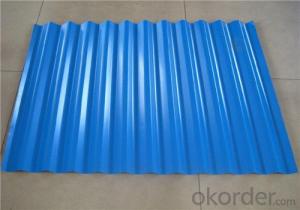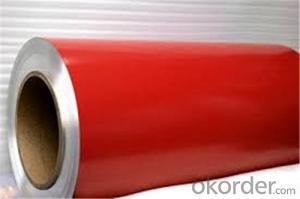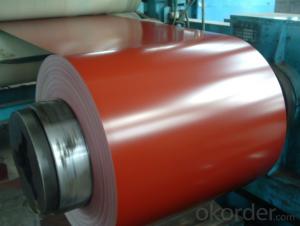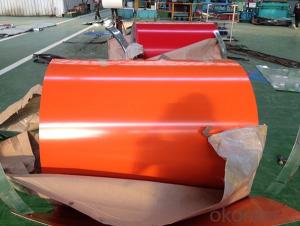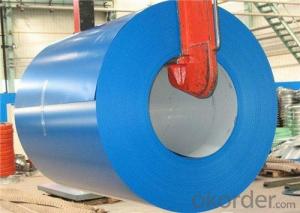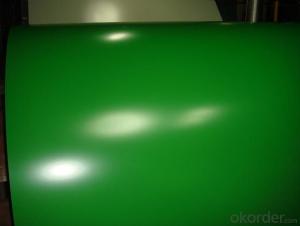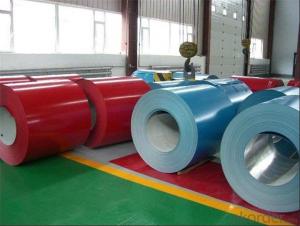Z31 BMP Prepainted Rolled Steel Coil for Construction
- Loading Port:
- Shanghai
- Payment Terms:
- TT OR LC
- Min Order Qty:
- 100 m.t.
- Supply Capability:
- 30000 m.t./month
OKorder Service Pledge
OKorder Financial Service
You Might Also Like
Structure of Z31 BMP Prepainted Rolled Steel Coil for Construction
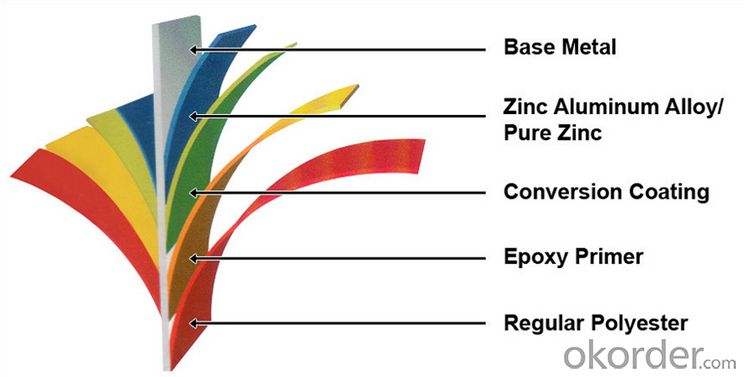
Description of Z31 BMP Prepainted Rolled Steel Coil for Construction
1. Prepainted steel coil is coated with organic layer, which provides higher anti-corrosion property and a longer lifespan than that of galvanized or galvalume steel sheets.
2. The base metals for prepainted steel coil consist of cold rolled, HDGI Steel, electro-galvanized and hot-dip alu-zinc coated steel. The finish coats of prepainted steel coil can be classified into groups as follows: polyester, silicon modified polyesters, polyvinylidene fluoride, high-durability polyester, etc.
3. The production process has evolved from one-coating-and-one-baking to double-coating-and-double-baking, and even three-coating-and-three-baking.
4. The color of the prepainted steel coil has a very wide selection, like orange, cream-colored, dark sky blue, sea blue, bright red, brick red, ivory white, porcelain blue, etc.
5. The prepainted steel coils can also be classified into groups by their surface textures, namely regular prepainted sheets, embossed sheets and printed sheets.

Main Feature of Z31 BMP Prepainted Rolled Steel Coil for Construction
Uncoated CR steel sheet
With the features of in line with the international highest standards in demension and shape, excellent surface finish and properties, the products are mainly used in home appliance and automobile industries.
Galvanized steel sheet(include HDG and EG)
With the features of good corrosion resistance, the products are mainly used in automobile, home appliance, electronics, building and machinery manufacture industries, etc.
Precoated steel sheet
With the features of enviromental protection and good processablility, long lasting surface durability, rich in colors, the products are maily used in building, home appliance and furniture industries, etc.
Applications of Z31 BMP PPGI Prepainted Rolled Steel Coil for Construction
A. Corrugated design makes it excellent waterproof performance
B. Materials as prepainted steel sheets, galvanized steel sheets, galvalume (Al-Zn coated sheets) are available to make corrugated sheet.
C.Those material are durable, anti-corrosion in bad weather for 20-30 years based on it's Zinc(Galvanized) coating or AZ (Galvalume) coating.
D. Different shape of the sheet make it suitable for any style of buildings.
E.Easy to install, no need special tools to fix the sheet.
F.Light weight due to high strength to weight ratio of steel. Light weight means easier handling lower shipping costs, easier installation
G. Different color is availbe base on the RAL Standard make your building more beautiful.
H. We will provide the best solutions if you don't have a exact idea of the specification you want for the steel sheet based on your weather conditions, engineering structure, construction budget and so on.
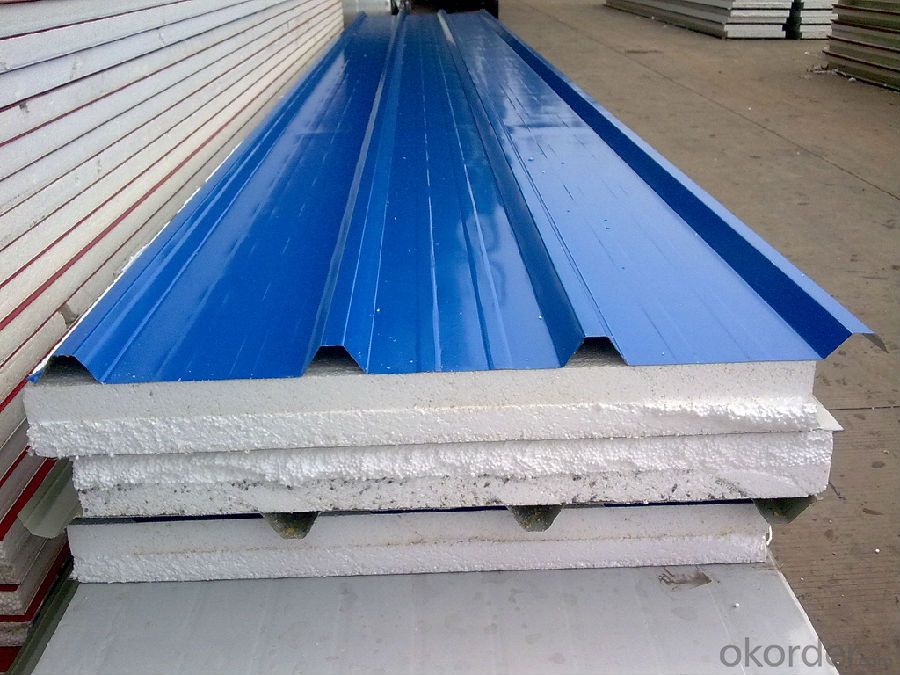
Specifications of Z31 BMP Prepainted Rolled Steel Coil for Construction
Product | Z31 BMP Prepainted Rolled Steel Coil for Construction |
Material Grade | SGCC / SGCH / DX51D+AZ, etc |
Thickness | 0.6-3.0mm |
Width | 500-1500mm |
Tolerance | Thickness: +/-0.02mm , Width:+/-2mm |
Zinc-coating | Z30-150g/m2 |
Technique | Raw material: Hot rolled steel coil --> Cold rolled_>hot dipped galvalume |
Surface | Dried, Chromated, Unoiled |
Spangle | Regular spangle , small spangle, zero spangle |
ID | 508MM 610MM |
Coil weight | 1-25MT |
Export package | Cardboard inner sleeves, Waterproof paper, galvanized steel covered and steel strip packed |
FAQ of Z31 BMP Prepainted Rolled Steel Coil for Construction
We have organized several common questions for our clients,may help you sincerely:
1. How Can I Visit There?
Our company is located in Tianjin City, China, near Beijing. You can fly to Tianjin Airport Directly. All our clients, from home or aboard, are warmly welcome to visit us!
2. How Can I Get Some Sample?
We are honored to offer you sample.
3. Why choose CNBM?
Our delivery time about 15-20days for standard sizes, if you have other requirements like hardness, quanity and width ,it is about 20-40days. But don't worry we also try our best for the delivery time ,because time longer and our cost is higher.
- Q: Hello,I have been thinking about buying a Tungsten Carbide Diamond wedding band for my husband but one of my family members keep telling me that Tungsten Carbide is merely steel and hence, a low quality metal, therefore, I shouldn't buy it. I don't really know much about it. Please if anyone can tell me more about this metal? Thanks.
- Tungsten is not steel. Tungsten is a chemical element. What they do is add an alloy mixture to tungsten and it turns into Tungsten Carbide. You want to find a ring with a nickel alloy, some manufacturers cheap out and add cobalt instead. Make sure the ring you buy does not contain cobalt. Steel is an alloy consisting mostly of iron, with a carbon.
- Q: where to buy Transformer steel?Used in transformers and electric motors.
- Electrical Steel Suppliers
- Q: How do steel coils contribute to the HVAC ductwork industry?
- Steel coils are an essential component in the HVAC ductwork industry as they are used to fabricate and shape the ducts. The coils are formed into various sizes and shapes, allowing for efficient air circulation and distribution within heating, ventilation, and air conditioning systems. These durable coils provide structural integrity to the ductwork, ensuring a reliable and long-lasting solution for HVAC installations.
- Q: What are the common size limitations for steel coil production?
- The size limitations for steel coil production can vary based on various factors, including the type of steel used, the manufacturing process, and the available equipment. However, there are generally accepted size limitations in the industry. One primary constraint is the width of the steel coil, which is typically determined by the size of the rolling mill or slitting equipment used in production. Standard widths for steel coil production range from approximately 600 millimeters (23.6 inches) to 2,000 millimeters (78.7 inches). Nonetheless, specialized equipment and processes can achieve widths outside of this range. Another limitation is the thickness of the steel coil, which can be influenced by the type of steel, intended application, and manufacturing capabilities. Common thicknesses for steel coils range from 0.15 millimeters (0.006 inches) to 6 millimeters (0.236 inches). However, specialized equipment and processes may be required to produce thicker or thinner coils. The weight of the steel coil is also an important consideration, typically determined by the capacity of production and handling equipment, as well as transportation limitations. Standard coil weights range from a few hundred kilograms to several tons. However, larger equipment or dividing the coil into smaller coils can enable the production of coils that exceed these limits. In addition to width, thickness, and weight, there may also be limitations on the length of the steel coil. This can be influenced by factors such as the size of the production line, handling and transportation capabilities, and customer requirements. Standard coil lengths typically range from a few meters to several tens of meters. However, specialized equipment and processes can produce longer coils. It is important to note that these size limitations are not fixed and can vary depending on project or customer requirements. Manufacturers often collaborate closely with customers to determine the optimal size limitations for their steel coil production, ensuring the final product meets desired specifications.
- Q: What are the common methods of testing the durability of steel coils?
- There are several common methods used to test the durability of steel coils. These methods evaluate the strength, performance, and resistance of steel coils to various stresses and conditions. Some of the most widely used methods include: 1. Tensile testing: This method involves subjecting steel coils to tension until they fail. It measures the maximum stress a coil can withstand before breaking or deforming. Tensile testing provides valuable information about the strength and ductility of steel coils. 2. Bend testing: This method evaluates the flexibility and resistance to deformation of steel coils. It involves bending the coil to a specified angle and examining whether it cracks or fractures. Bend testing is essential to assess the durability of coils in applications that involve bending, such as construction or automotive industries. 3. Impact testing: This method assesses the ability of steel coils to withstand sudden shocks or impacts. It involves striking the coil with a heavy object and measuring the energy absorbed or the extent of deformation. Impact testing is crucial in determining the toughness and resistance of coils to sudden loading conditions. 4. Corrosion testing: Steel coils are often exposed to corrosive environments, such as moisture or chemicals. Corrosion testing evaluates the resistance of steel to degradation caused by these corrosive agents. Methods like salt spray testing or electrochemical testing are commonly used to simulate and assess the durability of steel coils in corrosive conditions. 5. Fatigue testing: This method evaluates the ability of steel coils to withstand repeated loading and unloading cycles. It involves subjecting the coil to cyclic stresses until it fails. Fatigue testing is crucial in industries where coils are subjected to repetitive loading, such as in machinery or infrastructure applications. 6. Hardness testing: This method measures the resistance of steel coils to indentation or scratching. It provides information about the strength and wear resistance of the material. Common hardness testing methods include Brinell, Rockwell, and Vickers hardness tests. 7. Non-destructive testing: In addition to destructive testing methods mentioned above, non-destructive testing techniques are also used to evaluate the durability of steel coils. These methods, such as ultrasonic testing, magnetic particle inspection, or X-ray testing, allow for the detection of internal defects or flaws without damaging the coil. By employing these testing methods, manufacturers and industries can ensure that steel coils meet the required durability standards and perform reliably in their intended applications.
- Q: What is the process of uncoiling steel coils?
- The process of uncoiling steel coils involves carefully unwinding the tightly wound steel coil using specialized equipment. This typically includes a decoiler or uncoiler machine that holds and releases the coil, allowing it to gradually unwind. The coil is typically fed through a set of rollers or guides to ensure a smooth and controlled unwinding process. As the coil unwinds, it can be further processed or used for various applications, such as cutting, stamping, or forming into different shapes.
- Q: What are the common methods of testing the strength of steel coils?
- Some common methods of testing the strength of steel coils include tensile testing, hardness testing, and bend testing. Tensile testing involves applying a pulling force to the coil until it breaks, measuring the maximum force it can withstand. Hardness testing determines the steel's resistance to indentation or scratching, providing an indication of its strength. Bend testing involves bending the coil to a specific angle and examining if it fractures or shows signs of deformation.
- Q: What are the safety considerations when handling steel coils?
- There are several safety considerations that should be taken into account when dealing with steel coils. Firstly, it is crucial to wear the correct personal protective equipment (PPE), such as gloves, safety glasses, and steel-toed boots. This protective gear helps minimize the risk of injuries from sharp edges, flying debris, or accidental contact with the coils. Secondly, it is important to have a clear understanding of the weight and dimensions of the steel coils being handled. Steel coils can be extremely heavy, and improper lifting techniques can lead to back strains, muscle pulls, or even more severe injuries. Therefore, it is crucial to employ proper lifting techniques, such as bending the knees and maintaining a straight back, or using lifting equipment like cranes or forklifts when necessary. Moreover, steel coils can be unstable and susceptible to rolling or shifting during handling. To avoid accidents, it is vital to secure the coils adequately before moving or stacking them. This can be achieved by using appropriate lifting attachments, binding the coils together, or utilizing racks or other storage systems specifically designed for steel coils. Additionally, it is important to be aware of the potential hazards associated with the steel coils, such as sharp edges, oil or grease coatings, or even damage to the coils themselves. It is essential to inspect the coils for any irregularities or defects before handling them, as well as ensuring that they are stored safely and securely to prevent accidents. Lastly, proper communication and training are crucial when dealing with steel coils. Establishing clear channels of communication between workers is essential to ensure that everyone is aware of their roles and responsibilities. Furthermore, providing training on safe handling techniques, potential hazards, and emergency procedures can significantly reduce the risk of accidents and injuries. In conclusion, when handling steel coils, it is important to wear the appropriate PPE, employ proper lifting techniques, secure the coils adequately, be mindful of potential hazards, and ensure effective communication and training. By adhering to these safety considerations, the risk of accidents and injuries can be greatly diminished.
- Q: Explain why a steel nail sinks but a steel ship floats.
- surface area of the ship against the water is much greater than the nail.
- Q: What are the different methods of coil recoiling for narrow strip widths?
- There exists a variety of techniques for coil recoiling targeted at narrow strip widths. One technique, known as slitting and recoiling, entails slicing the wide coil into narrower strips and then rewinding them onto a smaller coil. This is typically accomplished using a slitting machine, which can make precise cuts to achieve the desired strip widths. Another approach, referred to as edge trimming and recoiling, involves trimming the edges of the wide coil to generate narrower strips. The remaining material is then rewound onto a smaller coil. This method is commonly employed when the coil edges are damaged or uneven and need to be removed before recoiling. Furthermore, there is a method called tension recoiling. In this process, the wide coil is threaded through a series of tensioning devices that aid in achieving the desired strip widths. The tensioning devices can apply controlled pressure to the coil edges, enabling precise recoiling of narrow strips. Additionally, some companies opt to employ laser cutting technology for coil recoiling. This technique entails using a laser beam to slice the wide coil into narrow strips, which are then rewound onto a smaller coil. Laser cutting offers exceptional precision and accuracy, making it an ideal choice for narrow strip widths. In summary, the various methods of coil recoiling for narrow strip widths consist of slitting and recoiling, edge trimming and recoiling, tension recoiling, and laser cutting. Each approach possesses its own merits and is selected based on the specific requirements and capabilities of the manufacturing process.
Send your message to us
Z31 BMP Prepainted Rolled Steel Coil for Construction
- Loading Port:
- Shanghai
- Payment Terms:
- TT OR LC
- Min Order Qty:
- 100 m.t.
- Supply Capability:
- 30000 m.t./month
OKorder Service Pledge
OKorder Financial Service
Similar products
Hot products
Hot Searches
Related keywords
